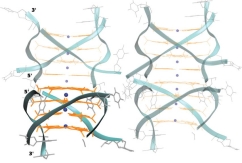Theelectrical conduction properties of G4-DNA are investigated using a hybridapproach, which combines electronic structure calculations, molecular dynamics (MD) simulations,and the formulation of an effective tight-binding model Hamiltonian. Chargetransport is studied by computing transmission functions along the MDtrajectories. Though G4-DNA is structurally more stable than double-stranded DNA(dsDNA), our results strongly suggest that the potential improvement ofthe electrical transport properties in the former is not necessarilyrelated to an increased stability, but rather to the factthat G4 is able to explore in its conformational spacea larger number of charge-transfer active conformations. This in turnis a result of the non-negligible interstrand matrix elements, whichallow for additional charge transport pathways. The higher structural stabilityof G4 can however play an important role once themolecules are contacted by electrodes. In this case, G4 mayexperience weaker structural distortions than dsDNA and thus preserve toa higher degree its conduction properties.

Theelectrical conduction properties of G4-DNA are investigated using a hybridapproach, which combines electronic structure calculations, molecular dynamics (MD) simulations,and the formulation of an effective tight-binding model Hamiltonian. Chargetransport is studied by computing transmission functions along the MDtrajectories. Though G4-DNA is structurally more stable than double-stranded DNA(dsDNA), our results strongly suggest that the potential improvement ofthe electrical transport properties in the former is not necessarilyrelated to an increased stability, but rather to the factthat G4 is able to explore in its conformational spacea larger number of charge-transfer active conformations. This in turnis a result of the non-negligible interstrand matrix elements, whichallow for additional charge transport pathways. The higher structural stabilityof G4 can however play an important role once themolecules are contacted by electrodes. In this case, G4 mayexperience weaker structural distortions than dsDNA and thus preserve toa higher degree its conduction properties.
